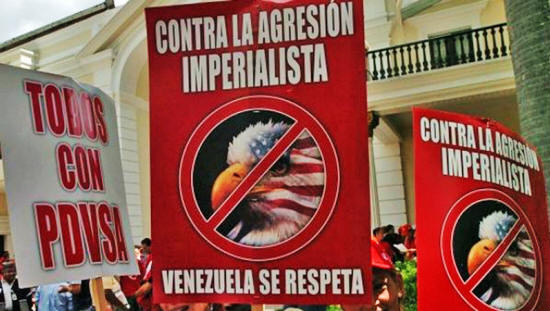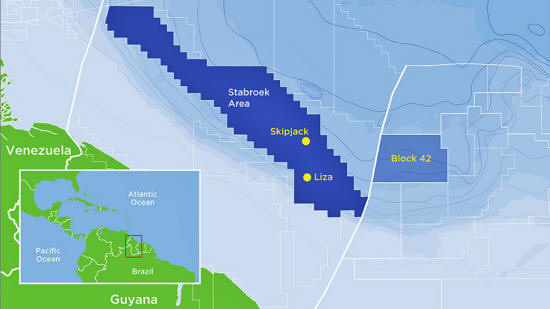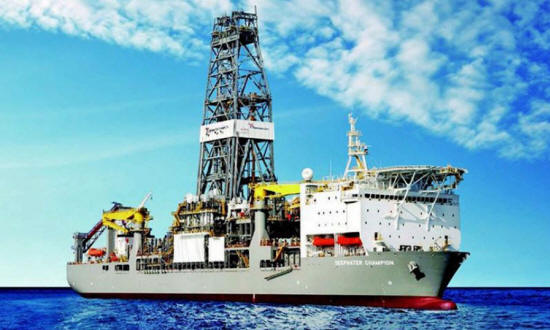|

by Mision Verdad
June 27,
2017
from
MisionVerdad Website
translation by
TelesurTV
from
TelesurTV Website
Original version in Spanish
Exxon wants to
topple Venezuela
for geopolitical
and geo-economic reasons

ExxonMobil's financing of Venezuelan opposition organizations
to generate acts of violence was revealed in a recent report.
Photo: EFE
ExxonMobil
awarded contracts to Guyana for
infrastructure, drilling and storage with a view to
extracting the huge oil and gas reserves from the
so-called "Liza
Project" located in maritime territory
claimed by Venezuela as stipulated by the Geneva
Agreement of 1966.
In 2015 the
first oil discovery in the area provoked a
diplomatic conflict between the nations due to the
activities of the oil company on the Atlantic front
of the Essequibo river.
'One of the
Biggest Oil Discoveries in the Industry of the Last Decade'
According to Gulf Oil & Gas, Dutch oil holding company SBM Offshore
NV has been granted a contract awarded by ExxonMobil, a U.S. company
that owns 45 percent of the Stabroek Block located on the Atlantic
front of the Essequibo through its subsidiary Esso Exploration and
Production Guyana Limited Atlantic, where the rich deposits of
Liza-1 and Liza-2 were found.
The CEO of the Dutch holding company Bruno Chabas commented
on the contract,
"We are proud that
ExxonMobil has awarded the Liza contracts to SBM Offshore. Liza,
the offshore field in Guyana, is one of the major oil
discoveries in the industry over the past decade."
However, this contract is
not the first by ExxonMobil to accelerate its plans for oil and gas
extraction in the territory claimed by Venezuela.
In May, a subsidiary of
the Italian oil company ENI named Saipem, took over the rights to
carry out,
"the engineering,
acquisition, construction, installation of associated bands,
structures and bridges" to Liza-1, according to the World Oil
website.
Recently teleSUR, citing
the U.S. Geological Survey, informed that the area concentrated in
the "Liza Project" is the second largest untapped oil fields in the
world.
With this latest contract awarded, ExxonMobil seeks to produce
120,000 barrels of oil and 170 million cubic feet of natural gas,
with a storage capacity of 1.6 million barrels of crude oil.
In total, the
Stabroek Block occupies an area of
26 thousand 800 km2 and it is estimated that 1.4 billion
barrels of high-quality oil is deposited in the Liza-1 field alone.

In 2015, Rex Tillerson, the current U.S. secretary of state
and former general manager of ExxonMobil, commented with joy to his
shareholders that this well (Liza-1) was the largest found anywhere
in the world that year, thus giving a strategic character to future
projects of the U.S. oil company.
Geopolitical
Urgency
The priority of this U.S. oil company to topple Venezuela is
geopolitical and geo-economic, as a fundamental pillar of a new
political, economic and financial configuration of the continent
(with Russia and China as alternative strategic partners), which
poses a threat to the strategic advantages and the almost absolute
control of the energy resources of the region that these
corporations boasted throughout the 20th century.
Securing that source of
supply not only enabled it to carry out its arms race and military
campaigns in the Middle East, but to maintain a global superpower
status which is challenged today by emerging rivals.
In the demarcation reinforced by this second round of contracts in
the Liza-1 and Liza-2 fields, there is an implicit interest in
appropriating an energy corridor as an Exxon exclusive exploitation
zone that runs from
the Orinoco Oil Belt, through
the Essequibo, reaching the mouth
of its Atlantic front.

The details drawn into the plans of the oil company are not only
energetic but also move to the political and diplomatic terrain, as
the takeover of political power in Venezuela by extraconstitutional
means would conclude in the appropriation of the other end of the
corridor - the richest on earth if the reserves of
the Orinoco Belt and those off the
shore of the Essequibo and the Stabroek Block are added together.
In the thick of it,
Russian and Chinese oil companies (Rosneft
and
Cnooc) are ahead in investments and
exploration projects that represent a serious threat to what the
largest U.S. oil company sees as a strategic source of supply for
their geopolitical global control plans.
Inescapable data
ExxonMobil's awarding of
contracts came just days after Venezuela and China signed four
large-scale energy partnership projects, ranging from increased oil
production to refining projects in the Asian giant.
The Coup
Master
In an investigation presented by Mision Verdad a few weeks
ago, ExxonMobil's financing of Venezuelan opposition organizations
to generate acts of violence was revealed, while at the same time
diplomatic maneuvers were being carrying out by the U.S. State
Department to revive the internal political conflict and to
repudiate the Venezuelan government in international organizations
such as
the OAS.
The last meeting of foreign ministers of the OAS on Venezuela, prior
to the organization's general assembly in Mexico, served to
illustrate how the oil corporation also manages the threads of the
international siege against the country.
The Guyanese government,
subordinate to its investments and currently the chair of
CARICOM, tried to impose a
resolution not agreed upon by the Caribbean states and identical to
the one presented by the U.S. at the last meeting, with the aim of
condemning the Venezuelan National Constituent Assembly.
The "red line" drawn by
the U.S. to camouflage rounds of much more aggressive sanctions
against the Bolivarian nation.
The Caribbean
as a Strategic Objective
The Caribbean is a mix of the circumstantial and strategic. The need
to overthrow
Petrocaribe is not just a
circumstantial calculation to break Venezuela's alliance with the
Caribbean and the support it receives against the diplomatic siege.
It is also run in parallel to the objectives of ExxonMobile, as the
company tries to maneuver into Guayana and politically and
economically reconfigure the Caribbean Basin to serve it purposes.
We have already mentioned that the U.S. oil company aims to make the
Caribbean dependent on the United Sates both politically and in
terms of energy by using its natural gas surplus (Exxon is a global
leader producer and exporter), while at the same time lining up its
batteries against Petrocaribe to regain geopolitical control of its
key maritime and commercial position, placing a barrier to stop
Chinese and
Russian capital from investing in
areas not only in the energy sector but also infrastructure and
transport.
Changes to the energy sector over the last decade have displaced its
core centers, both in supply and demand, to the Middle East, Central
Asia and Eurasia, and its productive matrix toward the production of
unconventional oil and gas (oil shale).
Whoever insures this
source of energy supply will undoubtedly have enormous geopolitical
advantages to dictate the global rules of the game in the coming
decades.
According to
a recent report of the
Inter-American Development Bank (BID),
more than 70 percent of global oil and gas reserves are in the
Atlantic basin.
ExxonMobil would undoubtedly be very pleased to achieve its plans
and retake the Caribbean by overthrowing the Venezuelan government,
the Petrocaribe pillar.
ExxonMobil's strategy is long-term, directed at the entire continent
and has Venezuela as its primary objective. It is not in vain that a
crew of business elites has assumed the reins of U.S. foreign policy
today.
There and not elsewhere
you will find the reasons for the aggressive siege we face.
|




